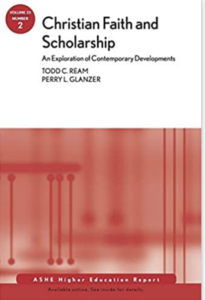
Christian Faith and Scholarship: An Exploration of Contemporary Developments
All are influenced by something, from their culture to their political ideals to their faith, and Todd Ream and Perry Glanzer in Christian Faith and Scholarship insist that such influences, particularly faith, should be embraced instead of ignored. With prolific references andsources, Ream and Glanzer demonstrate the reasonableness of wedding Christian faith and scholarship in both secular and Christian universities. Optimistically, they welcome Stanley Fish’s assertion that “religion” will replace “the triumvirate of race, gender, and class as the center of intellectual energy in the academy” (1-2).
In dealing with the role of religion, this volume, with respect to the series of which it is a part, is described in the Forward as atypical. Ream and Glanzer trace how the modern academy created a secular metanarrative and abandoned (to its detriment) the idea of faith-informed scholarship. The postmodern era, however, has ushered in a “tournament of historical and academic narratives” that opens the door once again for religious faith as one of many “valued and informed perspectives brought to bear on scholarly practices” (23). That Christian Faith and Scholarship is published in this Association for the Study of Higher Education (ASHE) series demonstrates the growing interest of the academy in religion and faith. This monograph allows the authors as Christian scholars to provide a Christian intellectual witness in the realm of a largely secular environment.
In describing the roles that various faith traditions played in encouraging, accommodating and/or resisting this secularization, Ream and Glanzer fault mainline Protestants for rushing to accommodate historicism in the arts and naturalism in the sciences, leading to a “two-realm theory of truth,” separating fact from value, which “proved disastrous for religion in the academy” (15). On the other hand, they give much positive attention to the critiques and examples of those from traditions outside of mainline Protestantism, from which comes the “stimulus for the current renaissance regarding religion and scholarship” (17).
The monograph reads like a bibliographic essay and provides an overview of Christian higher education, highlighting relevant issues. Proceeding by classification and example, the authors identify and briefly define three “faith-informed traditions of practical rationality” – Roman Catholic, Reformed, and Anabaptist; explore ways “faith-informed scholarship” works today “across the disciplines,” both in principle and through specific examples; and discuss the “practices” of faith-informed institutions, followed by a list of sample networks. The bibliography at the end provides many useful references in and of itself.
But Christian scholarship is not left in this study to “Christian” universities. Five different scholars argue not just that God is not dead, as Friedrich Nietzsche’s cultured despisers suggest, but also that “the secular university needs God (or at least religion), or it could die”(102). Although these critiques differ in detail, they all agree that “it is the contemporary secular narratives guiding the academy that are in some way limiting contemporary education and scholarship” (110). These limitations include a university that cannot justify its own existence or paint the bigger picture, that cannot provide any attention to character formation, that is limited in its epistemology, that is no longer culturally relevant, and that cannot address the most fundamental and most important questions (103-116). Indeed, Ream and Glanzer, and the authors that they review, deem that the university is in jeopardy of losing its soul (102).
As a remedy, Ream and Glanzer argue for the inclusion of faith-informed narratives and scholarship, along with a recognition of other “forms of sectarianism, be they liberal, religious, feminist, psychoanalyst, and so on” (116, quoting Gavin D’Costa). Increasingly it is being realized that personal beliefs play an important role in scholarly pursuits. If it is assumed that one’s feminism, Marxism, or nationalism will impact one’s scholarship, how much more so one’s Calvinism, Anabaptism, or Catholicism? After all, the authors explain, each has developed a distinct approach to scholarship. As we move further into a postmodern era of scholarship, religion should be seen once again as a valid contributor to a conversation that needs to be enlarged. Moreover, the particular vision of religious scholarship and education documented and espoused in this book provides what none of the other perspectives truly can: hope (117). This hope is both for church-related colleges and faith-informed scholars, whom Ream and Glanzer affirm as not only surviving but also playing a valuable role in the academy, and for the academy as a whole. Because interpretations are based on one’s worldview, and worldviews vary by person and experience, the Christian’s interpretation and worldview is no less valid than anyone else’s. In addition, the authors note that some Christian scholars believe that Christians have an advantage in this respect because they “have important reasons for seeing the world as a unified whole” instead of fragmenting reality to serve one’s specific interests (53). Potentially an integrative Christian perspective toward learning and scholarship could contribute to reconstituting the authentic character of the university.
By publishing with ASHE, Ream and Glanzer provide Christian scholars currency in the larger conversation with other schools of thought. There are, then, but minor caveats, beginning with the audience. If they intend to convince non-Christian academics to permit Christian scholarship within the secular university, those readers may be unfamiliar with as well as resistant to many concepts only briefly sketched here. Those who will actually read such a work are the very people who already understand the thrust of the arguments they make as they are naturally abreast of the current and accumulated literature regarding Christian learning and higher education. As W.E.B. DuBois noted regarding another form of “double consciousness,” this treatment of content may seem “twice-told tales” to the informed, and “Greek” to the uninitiated. One might wish for a less anecdotal citing of practitioners of Christian approaches, fewer assertions, and more help defining and arguing the essential principles of “practical rationality,” “faith informed scholarship,” and “academic freedom.” It would have been helpful had the authors provided explicit criteria for Christian scholarship, and advice for assessing models. Ream and Glanzer could include “next steps” for practitioners seeking to implement more effective Christian scholarship in their respective institutions, and a “best practices” section that cuts across the boundaries of individual institutions and programs. Such criteria would not only enhance their argument by providing points of engagement and credibility, but also invoke a simultaneous sense of belonging and urgency in what they are advocating. We can hope that their future endeavors will yield such fruits.
If aimed at current Christian practitioners, the study’s choices can seem partisan or at least partial regarding traditions, gender, and significance. Broadly, what about those who do not fit neatly within Roman Catholic, Reformed, and Anabaptist? In specific disciplines, for instance illustrating with literature, why is Susan Gallagher’s work not pursued as well as Roger Lundin’s, and where is Alan Jacobs? This overview lacks complexity and depth for any one discipline, and touches lightly upon some fairly complex issues. For example, the chapter on the “tournament of narratives” does not engage tensions between competing methods of inquiry among (and within) disciplines, between theory and praxis, and especially between rationality and belief – a key conflict between postmodern and Enlightenment assumptions.
From a Christian institutional perspective, there are ramifications for institutional politics and processes that could limit this explosion of secular scholarship with inhibitions and prohibitions circumscribing academic freedom. The authors describe the issue of academic freedom in the context of both religious and nonreligious institutions and argue that Christian colleges may provide even more academic freedom than nonreligious institutions for faculty members and students by providing a compatible framework from which to work. But would new limitations be developed in efforts to curb the rising secularity evoked, simply out of fear for loss of mission, heritage, and a weakened definition of a Christian college? Issues regarding academic freedom deserve more sophisticated treatment than this work provides. From a discipline-specific perspective, how are the ideals for scholarship kept within the boundaries of the Christian institution if too much pluralism emerges? The reader is left to struggle with the fact that pluralism and secularization are not the same, nor are they mutually exclusive.
Ream and Glanzer ’s positions, coming from an openly Christian perspective, will not sit well with those in the secular academy for whom any conversation about religion and scholarship is automatically judged a threat to the latter (viii). Those made uncomfortable should note that among the scholars the authors consider, none “hopes for a return to the older days of Christian hegemony,” but rather they argue collectively for an academy that is “more pluralistic and more just with regard to addressing metaphysical or religious issues”(116). The details of how proponents of a postmodern suspicion of metanarrative can be convinced to accept or even acknowledge scholarship infused with religious, specifically Christian conviction, which tends toward exclusivity, remain to be worked out.






















